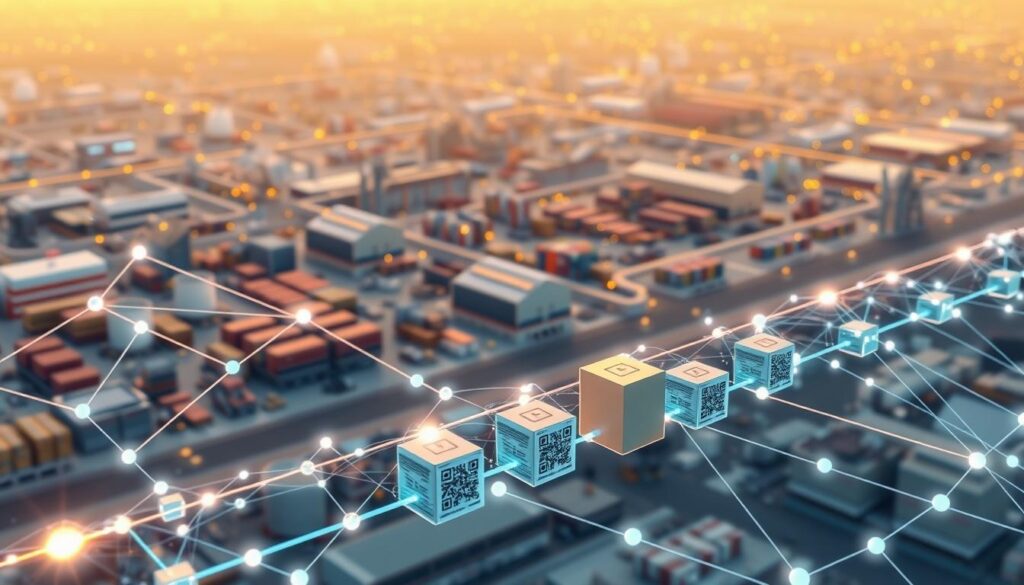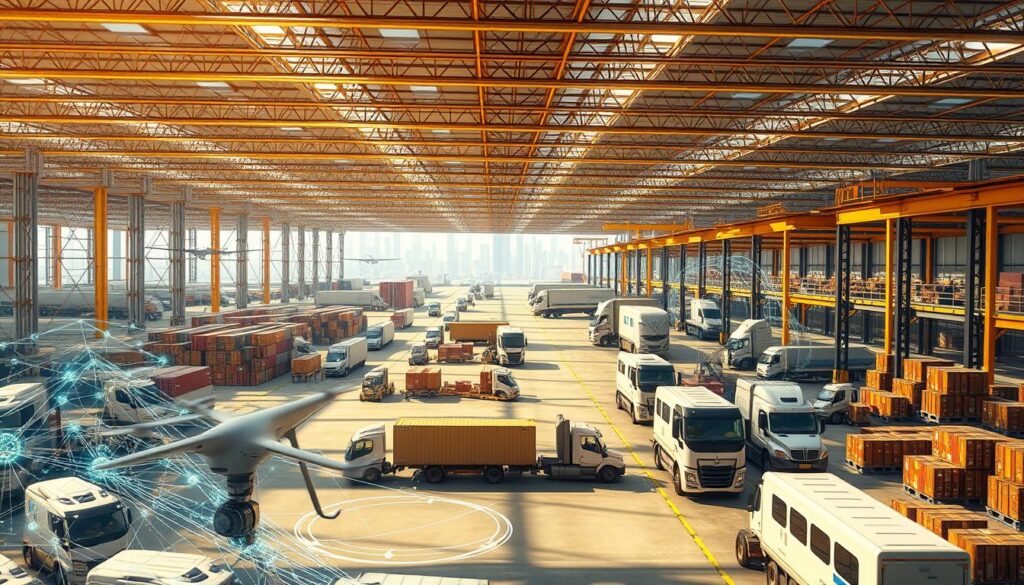Modern businesses face growing pressure to track goods from factory floors to store shelves. Traditional record-keeping methods often create information gaps between manufacturers, shippers, and retailers. Decentralized digital ledgers now offer solutions through shared data networks visible to all authorized participants.
These distributed systems store transaction records across multiple locations simultaneously. Each entry becomes part of an unbreakable sequence, creating permanent timestamps for every product movement. This approach eliminates single points of failure while maintaining identical records for all network members.
Food producers and pharmaceutical companies already use these tools to verify product origins. A recent industry report showed 67% of major US manufacturers now test digital tracking solutions. Real-time visibility helps reduce counterfeit goods and streamline recalls when issues arise.
The system’s security comes from advanced encryption and consensus protocols. Unlike conventional databases, changes require network-wide approval. This structure builds trust between companies that might otherwise hesitate to share sensitive operational data.
As global trade grows more complex, these innovations address critical needs for accountability. From raw materials to finished products, every step becomes documented in ways previously unimaginable. This shift marks a fundamental change in how businesses manage multi-stage production processes.
Understanding the Fundamentals of Blockchain Technology
At its core, blockchain solves a critical problem in digital record-keeping: creating trust without centralized control. Unlike standard databases managed by single entities, this approach spreads information across networks through synchronized copies. Every participant maintains identical records that update simultaneously.
What Makes This System Unique?
Three features define this innovation:
- Decentralization: No single organization controls the network
- Encryption: Advanced cryptography locks data into unalterable blocks
- Consensus: Majority approval required for new entries
These mechanics ensure tamper-resistant records. For example, altering one copy wouldn’t match others, triggering automatic rejection. This design originally powered cryptocurrencies but now secures medical histories and shipping logs.
Comparing Digital Storage Methods
| Blockchain | Traditional Database | |
|---|---|---|
| Control | Distributed | Centralized |
| Security | High (encrypted chains) | Variable (firewalls) |
| Transparency | Full visibility | Limited access |
Companies handling sensitive data increasingly prefer decentralized systems. A 2023 IBM study found 81% of enterprises prioritize solutions with built-in audit trails. When errors occur, pinpointing issues takes minutes instead of weeks.
How blockchain technology is transforming supply chain management systems
Global commerce relies on intricate webs of partners working across continents. With 73% of companies managing over 100 suppliers, verifying product journeys grows harder yearly. Shared digital ledgers address this challenge by giving equal data access to all authorized participants.
The Role of Decentralization in Enhancing Trust
Traditional models centralize information with one organization, creating bottlenecks. Decentralized networks spread control across multiple parties. This setup ensures no single entity can alter records without others noticing.
Key benefits include:
- Instant verification: All stakeholders see shipment updates simultaneously
- Reduced disputes: Shared records prevent conflicting reports between partners
- Fraud prevention: Consensus rules block unauthorized changes
| Aspect | Traditional Systems | Decentralized Networks |
|---|---|---|
| Data Control | Single authority | Multiple validators |
| Transparency | Limited access | Full visibility |
| Security | Password-protected | Cryptographic locks |
Pharmaceutical companies now track temperature-sensitive vaccines using these networks. Each handling step gets recorded permanently, from lab to clinic. If storage conditions deviate, alerts notify all parties immediately.
Retail giants reduced counterfeit goods by 89% after adopting shared tracking systems. Suppliers update product origins in real time, letting customers scan QR codes for full histories. This level of openness rebuilds consumer confidence in complex chains.
Enhancing Transparency, Traceability, and Trust Across Supply Chains
Visibility gaps in global trade routes cost businesses billions annually. Shared digital ledgers now provide live updates accessible to suppliers, carriers, and buyers simultaneously. This eliminates the “who knew what when” conflicts that plague traditional systems.

Real-Time Tracking and Provenance
Modern tracking tools show a product’s location and condition like a live map. Temperature-sensitive items like pharmaceuticals display storage history alongside GPS coordinates. Farmers use these systems to prove organic certification from seed to supermarket.
Three critical advantages emerge:
- Instant validation: Retailers confirm shipments meet standards before accepting goods
- Historical clarity: Every handoff appears in timestamped records
- Consumer access: Shoppers scan QR codes for material origins
Reducing Fraud Through Immutable Records
Altered documents cause 23% of supply chain disputes according to recent transparent supply chains research. Decentralized networks lock data using cryptographic seals. If a supplier changes shipment details, the edit appears as a red flag to all participants.
Food safety teams now trace contamination sources in hours instead of weeks. A 2023 seafood recall demonstrated this – officials identified affected batches through permanent harvest records. This precision protects brands while ensuring public safety.
Boosting Efficiency and Cutting Costs with Blockchain Solutions
Businesses seeking operational improvements are turning to automated solutions that slash paperwork and accelerate workflows. These innovations reduce delays caused by manual approvals while minimizing financial leaks across global networks.

Automating Processes with Smart Contracts
Self-executing agreements built on code streamline repetitive tasks like payments and quality checks. When shipment sensors confirm delivery, funds release automatically to suppliers. This removes billing disputes and accelerates transaction cycles by 78% in cross-border trade.
Key advantages include:
- Error reduction: Automated data entry cuts mistakes by 92% compared to manual methods
- Fee elimination: Direct peer-to-peer transactions bypass third-party brokers
- Resource optimization: Staff focus shifts from paperwork to strategic planning
| Process | Traditional Method | Blockchain Approach |
|---|---|---|
| Payment Processing | 5-7 business days | Instant upon delivery |
| Quality Checks | Manual inspections | IoT sensor triggers |
| Customs Clearance | Paper documentation | Digital compliance stamps |
Retailers using these systems report 34% lower administrative costs and 41% faster order fulfillment. A clothing brand reduced shipment disputes by automating fabric quality verification through smart contracts. Suppliers now receive payments within hours instead of weeks.
Overcoming Challenges and Technical Complexities in Blockchain Integration
Adopting decentralized networks requires careful navigation of technical roadblocks. Many organizations struggle to merge new protocols with decades-old infrastructure while maintaining operational continuity.

Integrating with Legacy Systems
Older software often lacks APIs to connect with modern decentralized networks. This creates three primary issues:
- Data translation errors: Format mismatches between old and new platforms
- System downtime: Migration phases disrupt daily operations
- Retraining costs: Employees need updated technical skills
A 2024 Deloitte study found 68% of enterprises face compatibility issues during implementation. Automotive manufacturers report spending 23% more than budgeted when updating warehouse tracking systems.
| Integration Aspect | Legacy Systems | Blockchain Solutions |
|---|---|---|
| Data Format | Proprietary structures | Standardized protocols |
| Update Frequency | Annual patches | Real-time upgrades |
| Access Control | Role-based permissions | Cryptographic verification |
Addressing Scalability and Security Concerns
Network performance often degrades as transaction volumes grow. Public ledgers handling 10,000+ daily entries require optimized consensus mechanisms. Private networks used in sustainable agriculture initiatives show better throughput through permissioned nodes.
Security remains paramount with sensitive shipment data. While encryption protects records, key management introduces new risks. Multi-signature wallets and hardware security modules now help companies balance accessibility with protection.
Leading logistics providers achieve 99.9% uptime using hybrid architectures. These combine private transaction channels with public verification layers – maintaining speed without compromising auditability.
Practical Blockchain Applications and Real-World Use Cases
Companies across multiple sectors now implement advanced tracking systems to ensure product integrity. These solutions address critical challenges like counterfeit prevention and ethical sourcing while meeting consumer demands for transparency.

Track & Trace Innovations in Logistics
IoT sensors paired with decentralized ledgers create unbroken digital trails for shipments. A European auto manufacturer reduced parts misplacement by 63% using real-time location updates. Temperature-sensitive medications now travel with embedded monitors that alert distributors if conditions deviate.
| Feature | Traditional Logistics | Decentralized Tracking |
|---|---|---|
| Data Updates | Manual entry | Automatic sensors |
| Issue Detection | Post-delivery | Real-time alerts |
| Recall Speed | Weeks | 48 hours |
Industry Case Studies Across Diverse Sectors
Luxury watchmakers embed digital certificates to combat counterfeits. Shoppers verify authenticity via mobile scans showing production details. Coffee exporters use geotagged harvest records to prove fair-trade practices.
- Pharmaceuticals: Vaccine batches tracked from lab to clinic
- Electronics: Conflict-free mineral sourcing verified
- Agriculture: Organic certifications linked to farm coordinates
These applications demonstrate how distributed systems solve industry-specific challenges. A jewelry brand increased customer trust by 89% after implementing origin verification tools.
Strategic Steps to Implement Blockchain in Your Supply Chain
Organizations ready to upgrade their logistics networks must approach decentralized systems with careful planning. Successful adoption requires aligning technical capabilities with operational goals while managing organizational change.
Launching Pilot Projects for Incremental Adoption
Begin by identifying high-impact areas where transparent tracking delivers immediate value. Partner selection proves critical – prioritize vendors offering:
- Modular platforms: Compatible with existing ERP and inventory tools
- Proven integration: Demonstrated success in your industry
- Scalable solutions: Capacity to grow with operational needs
Initial trials should focus on specific routes or product lines. A food distributor testing shipment tracking reduced documentation errors by 74% within three months. Measurable outcomes from pilots build stakeholder confidence for wider rollout.
| Implementation Aspect | Traditional Approach | Decentralized Solution |
|---|---|---|
| Partner Selection | Single vendor contracts | Multi-party ecosystem |
| Data Collection | Manual entry points | Automated IoT feeds |
| System Testing | Full deployment required | Phased pilot validation |
Training programs ensure teams understand new workflows. Focus on data stewards who maintain record accuracy across departments. Regular audits during pilot phases help refine processes before scaling.
Companies achieving successful integration report 68% faster issue resolution and 53% lower compliance costs. These metrics demonstrate why phased adoption outperforms rushed full-scale deployments.
Embracing the Future of Supply Chain Transformation
Global trade networks stand at a crossroads where collaboration defines success. Industry leaders recognize that decentralized systems reach full potential only through unified standards. Shared protocols enable seamless data exchange between suppliers, manufacturers, and retailers – turning isolated efforts into collective progress.
Consumer expectations now drive innovation as much as operational needs. Over 80% of buyers prioritize ethical sourcing, demanding proof of sustainable practices. Digital provenance tools meet this need by documenting every production phase, from raw materials to retail shelves.
Emerging technologies like AI and IoT sensors will amplify these systems’ capabilities. Predictive analytics could forecast delays before shipments leave docks, while smart contracts automate compliance checks. Such advancements require cross-industry partnerships to develop interoperable frameworks.
The path forward demands strategic alignment between competing organizations. Early adopters gain market advantages through enhanced traceability and faster issue resolution. Those delaying risk losing customer trust as transparency becomes the new operational baseline.
By embracing collaborative innovation, businesses unlock unprecedented accountability across global networks. This shift doesn’t just improve logistics – it redefines how industries build consumer confidence in an era of heightened scrutiny.
FAQ
What makes decentralized systems more trustworthy than centralized ones?
Decentralized networks eliminate single points of control, ensuring no single entity can manipulate data. This builds accountability among all participants, as every transaction is verified by multiple nodes and stored permanently.
How do immutable records reduce risks in global trade?
Once data is added to a distributed ledger, it cannot be altered or deleted. This permanence helps prevent counterfeit goods, unauthorized changes to shipment details, and fraudulent financial claims across international borders.
Can smart contracts replace manual paperwork in logistics?
Yes. Self-executing agreements automatically trigger actions like payments or shipments when predefined conditions are met. Maersk’s TradeLens platform, for example, uses this to cut document processing times by 40%.
What challenges arise when merging existing infrastructure with distributed ledgers?
Compatibility issues between older software and new protocols often require middleware solutions. Companies like IBM offer hybrid tools to bridge gaps without full system overhauls, though data synchronization remains complex.
Which industries benefit most from track-and-trace capabilities?
Pharmaceuticals (e.g., MediLedger’s drug verification) and food sectors (Walmart’s pork tracking in China) gain critical advantages. Real-time visibility ensures compliance, speeds up recalls, and validates ethical sourcing claims.
Why start with pilot programs instead of full-scale adoption?
Small-scale trials let businesses test workflows, identify technical bottlenecks, and measure ROI before committing resources. Nestlé’s coffee blockchain pilot in Zambia proved this approach reduces implementation risks.
Does enhanced transparency lead to higher operational costs?
Initially, integration requires investment, but long-term savings from reduced errors, faster dispute resolution, and optimized inventory often offset these. De Beers’ Tracr platform reduced diamond certification costs by 30% post-launch.


No comments yet